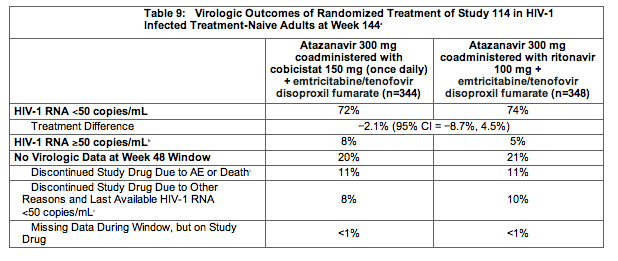| |
FDA Update - EVOTAZ (atazanavir/cobicistat) label was updated to include new data
|
| |
| |
Download the PDF here
The EVOTAZ (atazanavir/cobicistat) label was updated to include the 144 week data Sent from my iPhone
Under DOSAGE AND ADMINISTRATION, LABORATORY TESTING subsection was revised to include a recommendation to conduct routine monitoring during treatment. A new subsection for Hepatic Testing was added.
2 DOSAGE AND ADMINISTRATION
2.1 Laboratory Testing Prior to Initiation and During Treatment with EVOTAZ
Hepatic Testing
In patients with underlying hepatitis B or C viral infections, conduct hepatic laboratory testing prior to initiating therapy and during treatment with EVOTAZ [see Warnings and Precautions (5.6)].
2.3 Dosage in Patients with Renal Impairment
EVOTAZ is not recommended in HIV-1 treatment-experienced patients with end-stage renal disease managed with hemodialysis [see Use in Specific Populations (8.6) and Clinical Pharmacology (12.3)].
EVOTAZ co-administered with tenofovir DF is not recommended in patients with estimated creatinine clearance below 70 mL/min. Co-administration of EVOTAZ and tenofovir DF in combination with concomitant or recent use of a nephrotoxic agent is not recommended [see Warnings and Precautions (5.4) and Adverse Reactions (6.1)].
Section 4 CONTRAINDICATIONS, Table 1 has been edited to add elbasvir/grazoprevir and state Elbasvir/grazoprevir may increase the risk of ALT elevations due to a significant increase in grazoprevir plasma concentrations caused by OATP1B1/3 inhibition.
Subsection 5.4 has been updated with new week 144 study data:
In a clinical trial over 144 weeks (N=692), 10 (2.9%) subjects treated with atazanavir co-administered with cobicistat and tenofovir DF and 11 (3.2%) subjects treated with atazanavir co-administered with ritonavir and tenofovir DF discontinued study drug due to a renal adverse event. Seven of the 10 subjects (2.0% overall) in the cobicistat group had laboratory findings consistent with proximal renal tubulopathy leading to study drug discontinuation, compared to 7 of 11 subjects (2.0% overall) in the ritonavir group. One subject in the cobicistat group had renal impairment at baseline (e.g., estimated creatinine clearance less than 70 mL/min). The laboratory findings in these 7 subjects with evidence of proximal tubulopathy improved but did not completely resolve in all subjects upon discontinuation of cobicistat co-administered with atazanavir and tenofovir DF. Renal replacement therapy was not required in any subject.
Subsection 6.1 has been updated with the week 144 study data:
The information in subsection 12.2 has been revised and the Cmax information was added:
12.2 Pharmacodynamics
Cardiac Electrophysiology
Atazanavir: In a thorough QT/QTc study in 72 healthy subjects, atazanavir 400 mg and 800 mg (Cmax was 1.2 times and 2.4 times the Cmax observed with the recommended dosage of EVOTAZ, respectively) without a CYP3A inhibitor did not prolong the QTc interval to any clinically relevant extent. Asymptomatic prolongation of the PR interval was noted in subjects receiving atazanavir. The mean (±SD) maximum change in PRinterval from the predose for atazanavir 400 mg (n=65), atazanavir 800 mg (n=66), and placebo (n=67) was 24(±15) msec, 60 (±25) msec, and 13(±11) msec, respectively. Steady state atazanavir exposures (Cmax and AUCtau) observed in this healthy volunteer study exceeded those observed in patients treated with atazanavir coadministered with cobicistat. There is limited information on the potential for a pharmacodynamic interaction in humans between atazanavir and other drugs that prolong the PR interval of the electrocardiogram [see Warnings and Precautions (5.1)].
In 1793 HIV-infected patients receiving antiretroviral regimens, QTc prolongation was comparable in the atazanavir-containing and comparator regimens. No atazanavir-treated healthy subject or HIV-infected patient in clinical trials had a QTc interval >500 msec [see Warnings and Precautions (5.1)].
Cobicistat: In a thorough QT/QTc study in 48 healthy subjects, cobicistat 250 mg (1.7 times the recommended dosage in EVOTAZ) and 400 mg (2.7 times the recommended dosage in EVOTAZ) did not prolong the QTc interval to any clinically relevant extent. Asymptomatic prolongation of the PR interval was noted in subjects receiving cobicistat. The maximum mean (95% upper confidence bound) difference in PR from placebo after baseline correction was 9.5 (12.1) msec for 250 mg and 20.2 (22.8) msec for 400 mg dose of cobicistat.
Subsection 12.4, Microbiology, has been updated with week 144 study data:
Clinical Studies of Treatment-Naive Patients Receiving Atazanavir 300 mg Co-administered with Cobicistat 150mg: In an analysis of treatment-failure subjects who received atazanavir co-administered with cobicistat in Study 114 through Week 144, evaluable genotypic data from paired baseline and treatment-failure isolates from subjects who had HIV-1 RNA greater than or equal to 400 copies/mL were available for all 21 virologic failures in this group (6%, 21/344). Among the 21 subjects, 3 developed the emtricitabine-associated resistance substitution M184V. No subject developed the tenofovir-associated resistance substitution K65R or K70E, or any primary resistance substitution associated with protease inhibitors. In the ritonavir group, evaluable genotypic data were available for all 19 virologic failures (5%, 19/348). Among the 19 subjects, 1 developed the emtricitabine-associated resistance substitution M184V with no tenofovir- or protease inhibitor-associated resistance substitutions.
Section 14 has been updated with week 144 study data:
Virologic outcomes in Study 114 through Week 144 are presented in Table 9. In Study 114, the mean increase from baseline in CD4+ cell count at Week 144 was 281 cells/mm3 in patients receiving atazanavir co-administered with cobicistat and 297 cells/mm3 in patients receiving atazanavir co-administered with ritonavir.
Atazanavir 300 mg coadministered with cobicistat 150 mg (once daily) + emtricitabine/tenofovir disoproxil fumarate (n=344)Atazanavir 300 mg coadministered with ritonavir 100 mg + emtricitabine/tenofovir disoproxil fumarate (n=348)
Table 9: Virologic Outcomes of Randomized Treatment of Study 114 in HIV-1 Infected Treatment-Naive Adults at Week 144a
Atazanavir 300 mg coadministered with cobicistat 150 mg (once daily) + emtricitabine/tenofovir disoproxil fumarate (n=344)

The updated label will soon be available drugs@fda or DailyMed
Steve Morin
Office of Health and Constituent Affairs
Food and Drug Administration
Kimberly Struble
Division of Antiviral Products
Food and Drug Administration
Richard Klein
Office of Health and Constituent Affairs
Food and Drug Administration
|
|
| |
| |
|
|
|